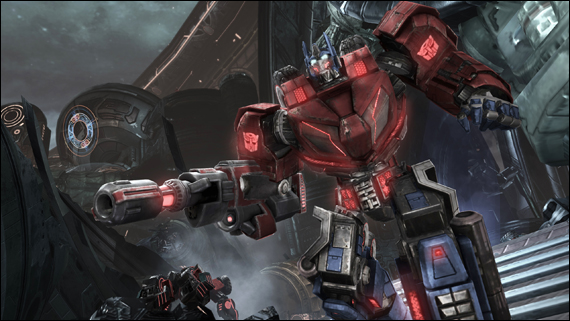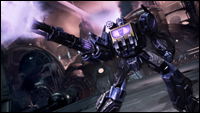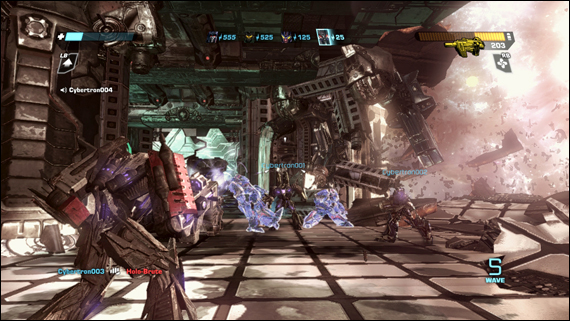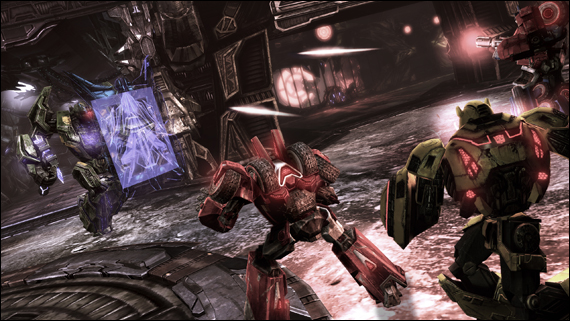
My familiarity with High Moon Studios is only through my unpleasant collision with the demo for their previous effort, The Bourne Conspiracy. With that product failing to resonate with me in any way despite my almost physical yearning for a Bourne game (later satisfied by Splinter Cell: Conviction), the discovery that these were the minds behind War for Cybertron was somewhat ominous.
It was encouraging to hear them speak on that game; it filled me with confidence and finally made the reality of the product that much more bitter. If you’ve followed the material released for War for Cybertron, then you may have experienced a similar swell of confidence: they speak as fans, and as you fire up the disc (or immaterial Steam delivery, as the case may be) there is no doubt as to their honesty. To my infinite relief, this release has been calibrated with great care for the Transformers follower, much in the way Arkham Asylum was a love letter to Batman adherents. While War for Cybertron does not quite reach the heights of the latter effort, it represents the game Transfans have long deserved.
Depositing players on the battle-ravaged Cybertron, the continuity of War for Cybertron overlaps largely with the Generation One era, but an argument could also be made for a relation to the abysmal Michael Bay movieverse. Existing in this sort of canonical grey area is probably intentional, and provides either variety of fan with impetus to check out the title. Players are offered the option to begin their battle for Cybertron via Autobot campaign or the Decepticon campaign, which precedes it chronologically. The events of the Decepticon campaign set up the Autobot entry in such a way that players who pursue the latter first will not feel lost, but the story is easily more rewarding when experienced as intended. Claims about two complete campaigns were somewhat exaggerated; clocking in at about five hours each, these are more accurately two halves of a single campaign of average length.
The distinction between the campaigns is ultimately window-dressing, offering a near-identical experience, often employing the same pacing and construction in addition to identical weapons, vehicle modes, and enemy types. However, each entry is colored by the faction you play: the Decepticon campaign is driven by mad ambition, where the player controls brutal, cackling machine monsters distinctly aware that they teeter on the edge of absolute victory; conversely, the Autobot perspective is characterized by weary optimism and resolve in the face of a losing battle.
The story is told in an episodic format, with players brought to speed by dictated recaps prior to each mission. Though capably told, the format employed here is sometimes problematic, with much of the intermediate area between missions told rather than shown to the player. The result is that the campaign can feel disjointed, with the plot lurching haltingly forward. The story itself is driven by “Dark Energon,” an unstable counterpart to the iconic Transformers energy source. The resource itself is ill-defined, with its properties and exact use vague, but it spurs on a fair Transformers tale. Through the campaign path players will find the game to be saturated in Transformers lore; you’ll control classics like Starscream and Soundwave, encounter such threats as Trypticon and Omega Supreme, and visit locations such as Iacon, capital city of the Autobots, all integrated capably into the core story.
Where fans will truly find purchase, though, is less in the unfolding story, and more in the banter of the robots as you play it through. There’s a distinct level of authenticity to the bickering of Starscream and the Decepticon flyers, Megatron’s overbearing speeches, the optimism of Bumblebee and the unshakable resolve of Optimus Prime. The dialogue and voicework (with Peter Cullen reprising his role as Optimus, but Frank Welker’s classic Megatron curiously absent) is crafted to represent these characters with a level of accuracy that will immediately speak to Transformers fans, and is characteristic of High Moon Studios’ dedication to presenting an authentic Transformers experience.

An integral part of this approach is also expressed in the elaborate art design. The ability to design a machine world that feels alive is not trivial, and it’s something that War for Cybertron fully exploits: bridges transform into existence, robots operate turrets and other equipment by incorporating their bodies into those devices, and weapons are scanned so that Autobots and Decepticons can reconfigure themselves to those specifications. The Transformers are a collection of constantly moving parts, with discs turning and pieces clicking into place as you play. Transformation is represented everywhere, designed sharply, satisfying both by providing impressive eye candy and with a feeling of true physicality. The characters themselves are designed with an obvious eye to their G1 counterparts, and where the films ultimately produced ugly, incoherent junkbots, War for Cybertron provides an excellent translation of the classic designs to more modern sensibilities.
There is a weakness, however, in the lack of variety in the environmental design. The attention to detail in the craft of Cybertron is impressive, but the environments appear largely the same from start to finish; every area is ravaged by war and no relief is provided in the form of peaceful or intact locations. Consequently, it is impossible to perceive Cybertron as a place where the inhabitants do anything but war with each other. This is not a problem unique to the game; throughout Transformers media, Cybertron has rarely been depicted as a place where anyone believably lives. The result is that while nicely designed, there’s little desire to explore Cybertron throughout your missions, as you’ve seen all you’re going to see almost immediately.

Playable character Soundwave doesn’t transform into a tape deck—and he only deploys his “cassette” minions when you face him in the Autobot campaign. Damn!
At the beginning of each mission the game presents three playable Transformers, each with a distinct load out including alternate mode, weapons, and abilities. The ability to change who and how you play throughout the campaign goes a long way towards making missions feel fresh. However, there are only four alternate modes in the game, and while each character’s configuration is unique beyond the matter of the vehicle mode, it’s that mode that can often dictate your choice of characters. Once you’ve played all four it’s easy to find yourself craving more. This is perhaps compounded by the fact that certain characters, like Megatron and Soundwave, lack their distinctive alternate modes and instead adapt more generic tank and truck modes, respectively. While there’s no doubt that transforming into a handgun or a tape deck could never represent a viable gameplay mechanic, these characters are somewhat diminished as a result. Furthermore, the ability to assume rare or unconventional alternate modes represents something of a missed opportunity.
The two robots not chosen by the player for that particular mission can be taken up by the AI or human allies for three player co-op—and there’s no doubt that co-op is the way this game is meant to be played. While it lacks the sophistication of dedicated co-op experiences (team work is largely limited to your ability to revive fallen allies), playing with friends dramatically ramps up the already chaotic gameplay mechanic. That mechanic is what sells this game.
The current generation of consoles has carried a set of commandments for third person shooters that demands slowing down the action. The imperative in the games of this type has become that the player must stop and take a seat before downing the next wave of enemies, with scenarios designed to pin the player down behind cover and immerse them in the experience of battle by making the open air a dangerous deathtrap. Stop-and-pop games present the player with the feeling of a tactical approach, and though this is largely illusory, it has made the mechanic extremely popular with players and developers alike. Transformers has opted for the path directly opposite: its mandate is that the player should move constantly, everywhere, and always. The action that has been crafted here is such that the player will tear through the mission, smashing waves of opposition and blasting across the map as a perpetually shifting robotic war machine. It’s a breath of fresh air to be offered such a fast-paced experience, and it’s easy to get swept up in the flow of transforming battles and laugh at the ridiculousness of what’s happening on screen.

The power of transformation is immediately addictive. Each vehicle form offers distinct opportunities for approaching combat, but the one shared absolute is the ability to tactically reposition yourself. Maybe you’re a truck ramming through the enemy line to transform and sweep them from behind, or changing into a jet to blast off and escape your imminent demise—but no matter what your alternate mode, you’ll invariably latch onto these modes as the lifeline they are. Transformation is swift and can be deployed in an instant, no matter your circumstances, and players may find themselves changing form constantly and at every opportunity, even if it’s only to traverse a short distance more quickly.
Ammo is scarce, though this is offset by vehicle weapons, which take from their own pool of ammunition, as well as powerful melee attacks. You’ll rarely find yourself completely defenseless; one of your modes is sure to carry loaded weaponry, but the reality of the situation is that you will often find yourself low on ammo for your preferred weapon. Ammunition only drops from the rare larger enemies, requiring players to rely on the predetermined ammo locations planted throughout levels. While there is an argument for demanding efficiency from players, the large, frantic conflicts this game thrives on make keeping an eye on your ammo counter-intuitive.
Bland mission design can also be problematic. The game changes pace by offering some occasional rudimentary platforming and some fantastic, high-energy driving sequences (enhanced by a tremendous soundtrack), but in between the combat plays the same from start to finish: your squad moves from one arena-like chamber to the next, downs a wave of enemies, and moves on. In another game this could be damning, but the variety afforded by your choice of robots, the breakneck pace of the action mechanic and the ability to constantly change form (and thus, approach) afford a level of dynamism that constantly refreshes what otherwise may have quickly become stale.

Friendly and enemy AI is similarly underdeveloped, with computer controlled characters transforming rarely (and never to any significant effect) and playing plainly—but the never-stop pace of the combat means you’re unlikely to ever notice. If you do slow down enough to take in the battle around you, you’ll see enemy characters don’t really employ tactics, they simply walk and shoot, while friendly characters tend to stand in one spot and fire uselessly, mostly ignored by enemy attacks. The enemy will kill you capably enough, and the dull AI won’t hamper your gameplay experience, but unfortunately it never feels as if the opposition is really an army of transformers—they might as well be any generic mechanical enemy in any other game. It’s strange that transformation could be so integral to every other aspect of the game, but completely irrelevant in the design of the enemies, and it dims the experience of fighting the iconic Transformer war.
In addition to the campaign, Escalation mode and Multiplayer are also offered, with the former taking notes from Call of Duty’s Nazi Zombie mode, and the latter inspired by the same series’ multiplayer. Escalation plays the same as the campaign, with players choosing from a selection of characters with predetermined loadouts, but pits the squad against waves of enemies in a confined space. Additional rooms, weapons, and items can be purchased with currency gained from each kill. This latest iteration of the trend started by Gears of War 2’s Horde Mode doesn’t offer any noteworthy innovations, but as with all aspects of War for Cybertron is elevated by the sharp design of the core gameplay, and it becomes a worthy diversion for players finished with the campaign.
Multiplayer presents a far more notable experience. The four classes—defined by a specific vehicle mode and distinct pools of available weapons, upgrades, and abilities—each follow their own path of unlocks, uncovered by playing that particular class. This allows players a range of customization for each class, while affording careful balancing; the superior jet form cannot be equipped with the powerful Scrapmaker minigun, and the nigh-invincible soldier can’t use the Warcry defense and armor buff. The available class customization, though, will ensure that every player finds their niche, and a generous schedule of unlocks will encourage you to often play just one more round. Transformation affords a unique twist to the brawls, making War for Cybertron’s multiplayer a standout effort
War for Cybertron, given the fervent dedication to Transformers mythology, will be most rewarding for longtime Transfans, but the frantic and exciting gameplay design, along with a killer multiplayer component will provide a solid experience for any gamer. While there is room for refinement in mission and enemy design, this entry establishes solid ground for a Transformers video game franchise for perhaps the first time. Hopefully Hasbro and Activision will follow through.
Transformers: War for Cybertron
Developer – High Moon Studios
Publisher – Activision
System – Playstation 3, Xbox 360, Microsoft Windows (Microsoft Windows Reviewed)
Release Date – June 22, 2010
*A copy of this title was provided by the publisher for review, however this review is based on an additional copy purchased by Gamesugar
Well, I’ll give the game at least a rental. Not that huge a Transformers fan, but a fun game is always a great experience.
Comment by EdEN — July 12, 2010 @ 11:22 am